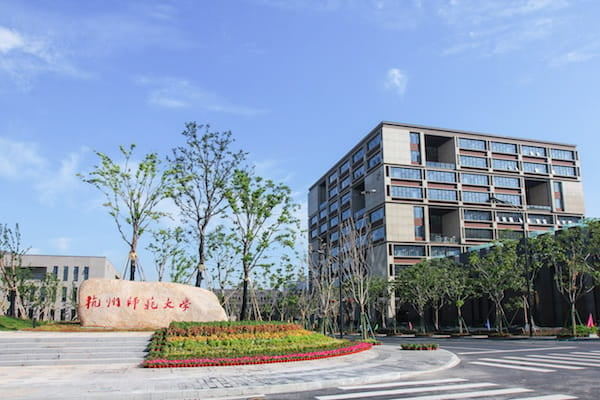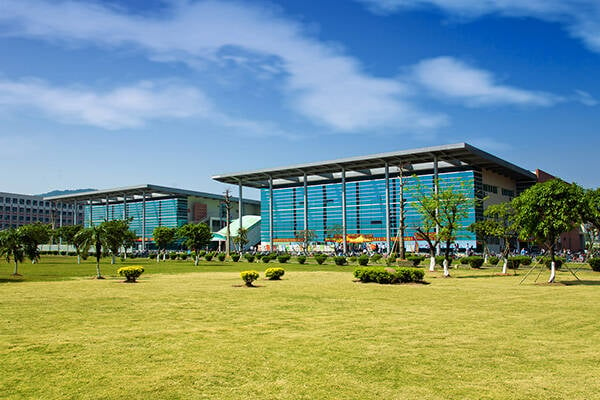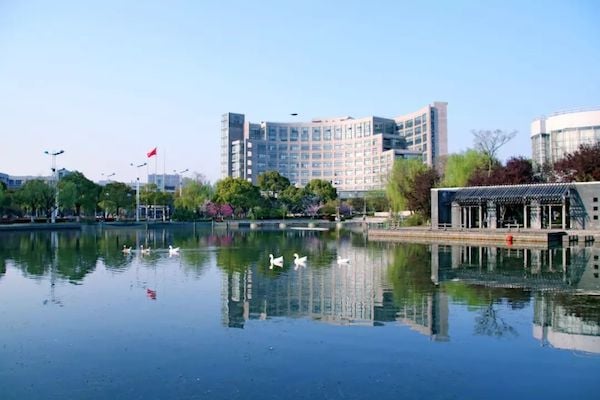
Guangdong Ocean University

![]()
Introduction to Guangdong Ocean University
Enjoying the joint sponsorship and co-construction of the State Oceanic Administration and the People’s Government of Guangdong Province, Guangdong Ocean University (GDOU) was established as a provincial key institution which features itself with Fishery and Marine disciplines. With 77 years of history, GDOU is now recognized as a multidisciplinary oceanic university which focuses on marine and fishery sciences and coordinates well in the development of science, engineering, agriculture, humanities, economics, management, law, and education, and of all these disciplines applied sciences relatively enjoy a predominate position. GDOU has cultivated over 100, 000 excellent practical talents for the society ever since its foundation, giving force to the development of Guangdong province as well as South China Sea studies and exploitations. Guangdong Ocean University was evaluated “excellent” according to the last Undergraduate Teaching Evaluation directed by the Ministry of Education of the PRC and it was granted a preliminary approval for establishing doctoral degree program.
Guangdong Ocean University has three campuses of different functions, viz. the Main Campus, Xiashan Campus and Haibin Campus, covering a total area of 4911 acres. The Main Campus where most of the classes are given is located nearby Huguangyan, one of the renowned world volcanic geo-parks; with its beautiful and quiet surroundings, it is praised by many as an ideal place for study.
Guangdong Ocean University is academically organized into 18 colleges, 26 research institutes (including Guangdong Ocean Exploitation Research Center, Key Research Base for Humanities and Social Sciences, and Marine Economy and Management Research Center, etc.), 1 self-contained college(viz. Cunjin college) and one department for Ideological and Political Theory Teaching.
The 18 colleges include College of Fisheries Science, College of Food Science and Technology, College of Marine Sciences and Meteorology, College of Agricultural Science, College of Engineering, College of Economics and Management, College of Navigation, College of Information Technology, College of Software Engineering, College of Science, College of Humanities, College of Law, College of Foreign Studies, College of Political Science and Public Administration, College of Sports and Leisure Studies, College of Art(co-founded with China National Song & Dance Ensemble), College of Vocational Education, College of Continuing Education.
Guangdong Ocean University is now establishing 3 first class disciplines for doctoral degree and enjoys 3 key disciplines on a provincial-level support. It has, currently, 22 master’s degree programs, 64 undergraduate majors and 39 majors for vocational programs, among which, there are 8 provincial to state level featured specialties, 2 provincial leading specialties and one provincial key major.
With well-equipped teaching buildings, museum, student’s dormitories, swimming pools, etc., Guangdong Ocean University enjoys a sound operation conditions, with a total value of 1,560 million yuan of fixed assets. Altogether the three campuses share a floorage of 720,000 square meters. Its well-stocked library contains books over 1,920,000 volumes. Teaching buildings and all 66 research centers are well-quipped with advanced facilities, including one state-level metric attestation center, 11 provincial key laboratories and engineering research centers as well as 4 model experimental teaching centers, worth 270 million yuan. With more than 3,000 aquatic life specimens, its Aquatic Museum boasts the richest display in all higher institutions across the country.
Guangdong Ocean University has 1100 teachers and researchers, of which there are over 500 senior professional title holders (professors and associate professors), 225 doctorate holders, 3 academicians, 2 Distinguished Professors under the Pearl River Scholars Program, 98 as collegiate academic heavyweights under the Thousand-Hundred-Ten Project of Guangdong Province, and 8 annuitants of Special Government Allowance from the State Council. Currently, GDOU has a student population of over 50,000, among which, around 28,000 undergraduates, postgraduates and international students live on the Main Campus, about 12,000 students in Cunjin collage, and more than 13,000 registered adults students.
Guangdong Ocean University holds the following philosophies as its educational and operational rationales: strengthening strength with top talents; sustaining prominence through high quality; promoting prosperity through outstanding research; extending popularity through disciplinary distinction, and embraces the schooling ideas of —promoting the enrollments and quality, with a focus on quality; advancing the extensions and intensions, with a focus on intensions; enhancing the general development and disciplinary distinction, with a focus on disciplinary distinction. With sustaining effort on optimizing the discipline structure, enforcing specialty construction, developing quality-oriented education, GDOU has seen a great improvement in the quality of teaching. The school enrolls students from 25 provinces, autonomous regions and municipalities directly under the Central Government and its graduates are reviewed favorably across the country. According to employment statistics, the past five years GDOU has maintained a 98% high graduates employment rate, ranking front among universities in Guangdong Province, and was awarded the provincial honor of “advanced collective” in promoting graduates employment in 2010. In recent five years, its students have won 3 international awards, 697 national awards, and 1620 provincial or ministerial prizes from high-level student competitions in arts, sports, science and technology. Furthermore, some students were invited to give performances at the Fifth Anniversary for the Shanghai Cooperation Organization, the Tenth Anniversary of Hong Kong’s Return, and the Tenth Anniversary of Macao’s Return and has been highly commended by the Ministry of Culture and the General Political Department of PLA.
These years have seen a profound development of Guangdong Ocean University in scientific research and as a public service provider. In the past five years, it undertook 1508 scientific research projects, among which many are state key projects including March 1986 Hi-tech programs, March 1997 State Plan for Development of Basic Research programs, state science and technology support programs and other state natural science and social science funds programs, with these it was granted research funds 248 million yuan and awarded 106 science and technology awards, of which there are 4 provincial and ministerial awards, first prize; 29 provincial and ministerial awards, second and third prize; and 1 National Science and Technology Award, second prize. Some of the projects awarded include “The critical technique for producing Flavoring Materials and Condiments with rich Peptide Flavors”(awarded the National Science and Technology Awards for Progress 2009, second prize), “High Efficiency Technology in Shrimp Industry in South China areas”(was awarded Guangdong Science and Technology Awards 2007, first prize, and Science and Technology Awards for Progress 2007, first prize, by China National Industry & Commerce Union) “Research and Application of Technology for Modeling Blister Pearl Processing and Salt-water High-quality Pearl Cultivating”(was awarded Guangdong Science and Technology Awards 2011, first prize), “Research and Model Testing-extension of Sand-covering Technique in Aquariums in Cultivating Marsupenaeus Japonicus and Penaeus Monodon”(was awarded Hainan Science and Technology Awards 2009, first prize), “A Study on Technology for Cultivating Argopecten Irradians Concentricus and its Extension” and “A study on the Standardized Farming of Pinctada Martensii and its Extension”(was awarded, respectively, National Awards for Marin Science and Technology Innovation and Achievement 2006 and 2008, Second prize). A lot of other technologies has reached or surpassed the international advanced level in their respective fields, including technology for Prawn breeding and culture, Aquaculture of Rare Marine Fishes, disease control and prevention technology of Marine Fishes, pearl oysters farming and pearl cultivating technology, technology for aquatic products storage and processing, marine drug exploitation and development, technology for hybrid rice breeding, etc. The flourishing of technologies has given great power for social and industrial development. With the application and extension of new technologies from GDOU, the marine fishery industry in southern China has developed fast in recent years and reaped substantial economic and social benefits. A good example can be found in pearl cultivating industry. With the technology support from Guangdong Ocean University, the pearl output in Zhanjiang boomed to account for two third of the total national output, and the same was seen in prawn industry, which makes up one sixth of the national total output.
Guangdong Ocean University perseveres substantive cooperation and interchange in research and academic studies both domestically and internationally, enjoying longstanding in-depth partnerships with universities in over 30 countries and regions, including in countries like the UK, Australia, Japan, and regions like Hong Kong, Taiwan, etc. from where it engaged a number of distinguished honorary professors, guest professors and adjunct professors and established joint-programs with Ocean university of China and National Taiwan Ocean University.
21st century is the century of the ocean. Ocean exploitation implies a lot for future development of our country. South China Sea, which accounts for more than two third of the country’s total sea territory, is vital for strong marine nation strategy and with its rich marine resources and crucial strategic position, it will naturally become one of the economic engines for the country’s development as an international active participant. Guangdong Ocean University, being the only one ocean university in South China Sea area, expectedly shoulders the historical mission of cultivating high-level professionals in marine science and technology, advancing marine science and technology innovation, and providing service for the development and utilization of South China sea resources.
Seizing the opportunity of state preferential attention in South China Sea research and exploitation as well as the strategic opportunity for building a robust marine economy of Guangdong province, putting great effort on quality and characteristics, optimizing operational and educational structure and management, emphasizing innovation and reform, Guangdong Ocean University is steadily moving on in shaping a prominent and influential comprehensive university in research and education both at home and abroad.
![]() Campus
Campus
Video Playlist
Introduction to Guangdong Ocean University
Life at Guangdong Ocean University
![]() Foreign Teachers
Foreign Teachers
![]() About Zhanjiang
About Zhanjiang
Zhanjiang (Panorama, City Website) lies in the southwest of Guangdong Province. It is situated in Leizhou Peninsular, neighboring the South Sea in the east and Beibu Gulf in the west. The city is separated from Hainan Province by Qiongzhou Strait.
Transportation
Zhanjiang Airport is the only airport in western Guangdong Province. It is only about 4 kilometers (2.5 miles) from the downtown area of the city.
Climate
Zhanjiang, which is located in the southern low-latitude region of the Tropic of Cancer, enjoys a tropical and subtropical monsoon climate. Regulated by a marine climate all year, it is neither severely cold in winter nor intensively hot in summer. The average annual temperature ranges between 22.7 C and 23.3 C, with mean annual sunshine duration reaching 1,864-2,160 hours and mean annual precipitation running up to 1,417-1,802mm.
Education and Research
So far, there are seven colleges and universities in Zhanjiang, second only to Guangzhou, capital city of Guangdong province. It also has 75 secondary vocational schools, 39,000 professionals and technical personnel, three key laboratories, six engineering research centers, 18 research institutes, and 47 technology development institutions affiliated to enterprises. Together, they have contributed a lot to Zhanjiang’s fast growth.
![]() Related Universities
Related Universities












